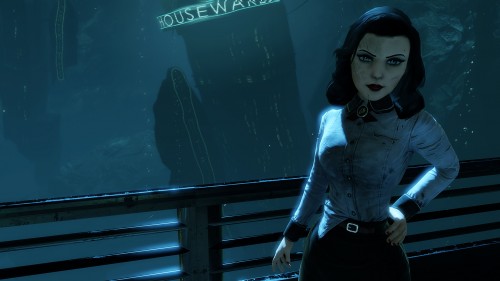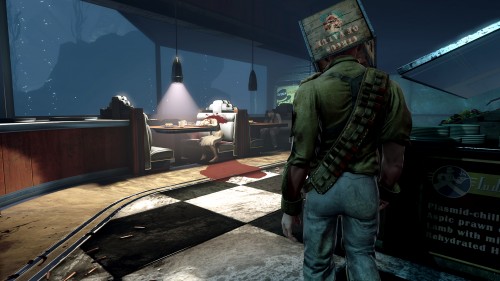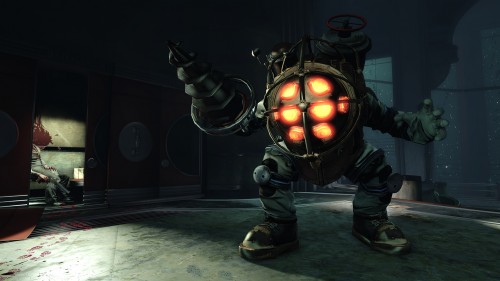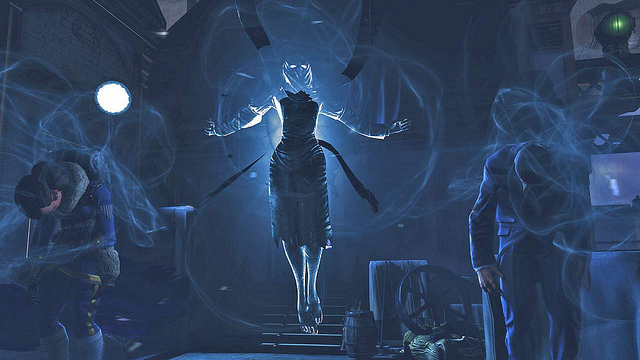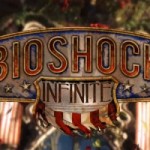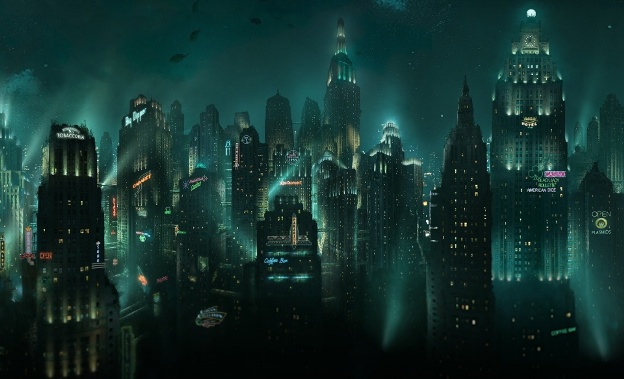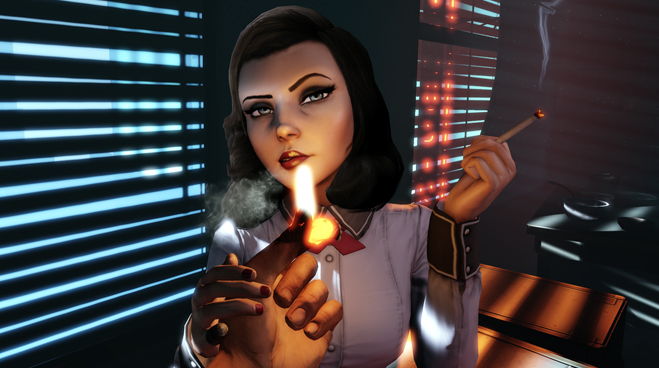
If you’re in possession of a BioShock Infinite season pass I’m guessing, like me, you’ve been holding out for new story content for a long time now. Though the game is only eight or so months old, the promise of additional story content in a narrative heavy game has been hindered by the first of the three season pass content packs focusing on arcade arena shooting instead of plot development. Clash in the Clouds is actually pretty good, if you’re fond of Infinite‘s combat design, but it’s no story, and I suspect that’s what a lot of BioShock fans want when they pony up money in advance.
Finally we’re here, as the first of a two part narrative arc launches. Titled “Burial at Sea“, this side story aims to leave the mysteries of Infinite‘s Columbia still untold in favour of a return to Rapture. Yes, BioShock‘s Rapture, but maybe not the exact Rapture that you know and love. Or something. It’s complicated, given Infinite‘s obsession with the multiverse. And it’s probably irrelevant. Ultimately, this is a mostly new story with a new Booker and new Elizabeth in a pre-devastated Rapture, providing plenty of fan service for those familiar with the franchise and…that’s about it.
Understanding where Burial at Sea goes wrong is quite easy when you look at what’s lovable about the original BioShock and BioShock Infinite. Though both share similarities in certain themes and formula, they each emphasise fundamental differences in narrative arcs and game design to provide players with a different experience. Combat balance and encounter polish tends to lean in favour of Infinite, while open exploration level design is more rewarding in the original BioShock. Burial at Sea attempts to combine the two, taking Infinite‘s combat nuances, play abilities, and narrative presentation and squeezing it into a classical Rapture-like level structure.
The opening hook is handled well enough. Booker the private detective wakes up in his iconic apartment, confused and disorientated in classic Infinite fashion. Enters a dame, Elizabeth, pressuring him on the disappearance of a girl named Sally. Booker refuses to divulge his relationship to the child, noting only that she’s been missing for a long time and likely dead. Elizabeth teases with knowledge that she’s alive, and she knows where to begin the search. And so begins their adventure.
This intriguing hook is followed by a sequence of fetch quests around a non-hostile Rapture hub zone. Similar to Infinite‘s opening, the goal is here is to take in the atmosphere. See the familiar sights of Rapture before it all went to shit. The intention is good, but the execution leaves much to be desired. NPCs are again stilted, minimally animated puppets waiting to play their two or three lines of pre-recorded dialogue when you’re in proximity. Elizabeth skittishly runs around, occasionally commenting on a contextual point of interest, while reminding you where you need to go to advance the narrative. The aim is obviously to reward BioShock fans with fan service, a window into another side of Rapture they recognise but have never properly seen. It’s just not anywhere near as magical as interesting as it should be. Much of Rapture’s interest comes from its desolate wonderland, the knowledge that times were once so much better but never being able to see them for yourself. You’re first hand experience is that of the aftermath. Rapture rewarded imagination and mystery, and Burial at Sea deliberately stifles it.
Exploring the Rapture hub (if you could call it a hub) lasts as long as you want it to. You can wander, browse the stores, listen to NPCs, and take in the atmosphere. Or you can get right to it and go where Elizabeth tells you to go, activating “talk” on the person she tells you to, and repeating this until you hit the hub’s visually splendorous (with significant fan service) climax. As an act of play, the bland simplicity of BioShock‘s structure is more obvious here than anywhere else. We’ve done fetch quests before, and with no combat or puzzle solving to break the pacing the hub’s game structure is a case of moving from A to B to C and pressing the use button where appropriate. Again, plenty of fan service, decent atmosphere, but dull as all hell to play, and more obviously so than than ever before.
Once you’ve hit this point you’ll be sent off to the combat zones, where Burial at Sea starts being an actual game and using all the mechanics available to the player. Though at its heart this is absolutely Infinite in play, a lot of work has gone into making changes to the presentation to suit Rapture. You won’t fight Columbian soldiers, you’ll fight Splicers. Salts wont replenish Vigors, instead Eve replenishes Plasmids. Functionally, many of Infinite‘s mechanics are exactly the same: renamed skyhook, bucking bronco, machine gun remodelled as the tommy gun, automated turrets remodelled, and so on. Additions are few, but welcome, including a cool new ice “Plasmid” that has you freezing and shattering opponents, as well as surfaces.
The latter point ties into the more open-like Rapture environments that encourage exploration. BioShock fans blasted Infinite for its linearity, and Irrational’s attempts to bridge the gap between the two titles is transparent, not working half as well as they probably intended. Ammunition is deliberately scarce, encouraging you to explore to restock. Yet this is negated by two points: obvious enemy spawn scripting that triggers every time you leave one room/zone and re-enter after exploring, burning through the ammunition you just found. And ammo/power stations in default, easy-to-find areas. Exhaust supplies to explore a new area, that rewards with ammo and money, use said ammunition as you return to the previous area, then spend that discovered money on ammunition to…resupply yourself. It’s a rather pointless feedback loop, again leaving exploration as only rewarding to those who want to soak in the atmosphere and discover side stories hidden away in audio diaries.
Second to general loot rewards are more significant bonuses, like shield/health/eve upgrade potions, extra plasmids/tonics, and new stat based clothing to equip. All ideas taken straight from Infinite, decent rewards on paper, not really relevant in Burial at Sea. Episode one is just…far too short to levy significance from long term upgrades. They’re incremental bonuses kinda okay to discover but hardly necessary for the next hour of basic combat encounters. Much like the hub’s fetch quest, Burial at Sea‘s weird exploration/loot/reward loop is really transparent and not effective at encouraging you to push forward and advance into new, optional territory.
I’ve been light on the narrative for this review, knowing the significance of story to BioShock fans and not wishing to spoil to the fun. What’s there is…okay. The opening hook is decent, but the narrative pacing is hindered by the short length, just like the long term loot upgrades. Objectives having mowing your way through splicers to find contextual “use” spots and repeating until the climatic and all-too-easy boss fight makes itself known. Burial at Sea too struggles to find a balance between BioShock lore and Infinite‘s narrative, relying on location and imagery for the former, yet adhering to tired multiverse tropes for the latter. Many of the “twists” and “surprises”, discovered either in the short narrative or optional audio diaries tease with the same kinda stuff Infinite already did. Suchong ponders the meaning behind tears. New characters stress over splicers. And the narrative climax is yet another somewhat info dump of Infinite-like revelations, even if it does pave interesting ground for episode two.
When it all comes to an end, pondering what story developments will come in episode two, I’m left wondering what Burial at Sea‘s identity is. And I’m at a loss. So reliant is Burial at Sea on drawing from both game’s pools of story and design that it excels at neither and establishes little identity of its own. I adore Rapture, but this is a lesser Rapture devoid of all intrigue and mystery. I enjoy Infinite’s play, but the more open levels and enemy respawing do nothing to elevate or even match Infinite‘s tighter linear design. The story is shrouded in mystery, but seems to offer little in the ways of expanding BioShock and Infinite, instead reliant on tired and all too familiar revelations.
Burial at Sea episode one is so overtly “BioShock” in its pandering to fan service and reliance on existing ideas that it fails to validate its own existence. Structurally it’s functional, but alongside the rest of the franchise it’s unnecessary, largely uninteresting, and disappointingly forgettable.
Fan service | Visually pleasing return to Rapture | Elizabeth is smoking hot
Uninteresting design | Reliant on tired mechanics and narrative tropes

